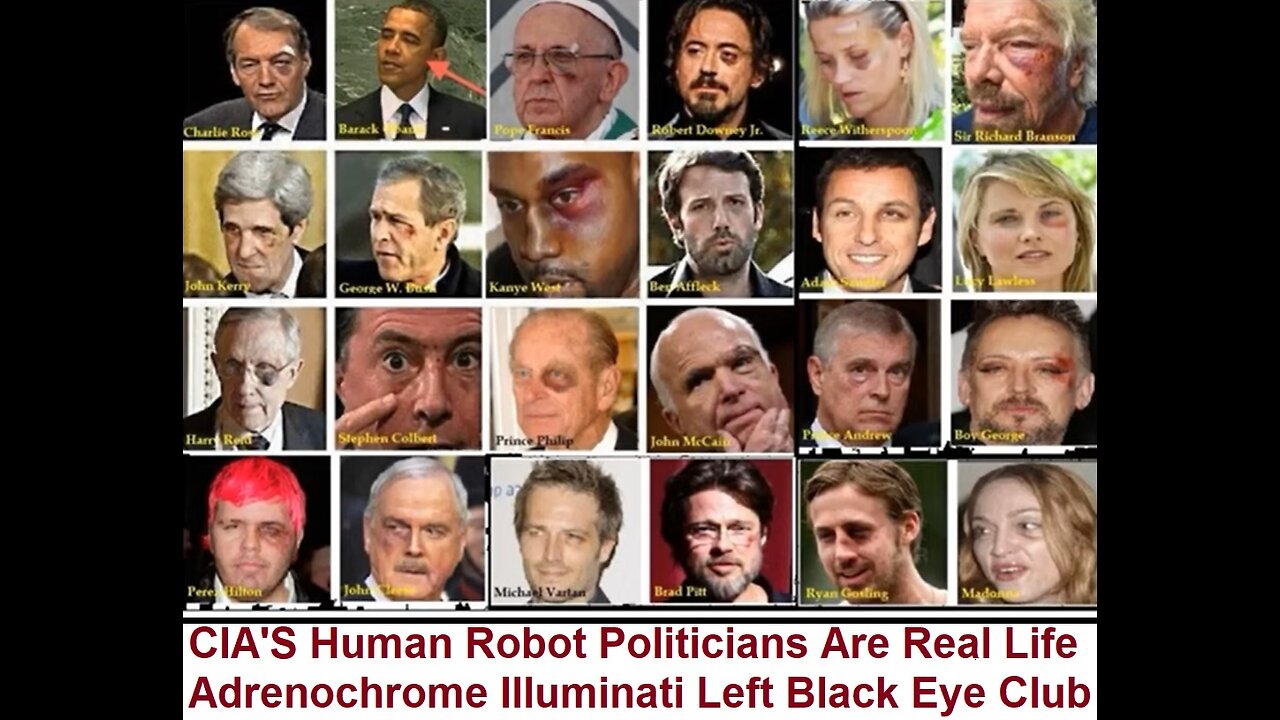Premium Only Content

CIA'S Human Robot Politicians Are Real Adrenochrome Illuminati Left Black Eye Club
Robot Politicians are real, are we ready for this? Dr David Levy claims the US White House or Britain’s Parliament will likely be occupied by AI in as little as 30 years. According to the computer science professor and author of Love and Sex with Robots, human politicians will be replaced by robots relatively soon due to a superior ability to make correct decisions. According to Dr Levy, “If you think about what a President or Prime Minister has to do, he has to make decisions about economic, political, health and transport matters. These types of decisions will eventually be made much better by an AI than by humans.”
Levy suggested that lawmakers gradually lose a voter’s trust. As an example, he pointed to recent Brexit developments and the “chaos” in the Trump administration, The Daily Star said.
This is not the first time someone suggested we should replace politicians with robots and AI. A robot ran for mayor in Japan, while another robot will run for prime minister of New Zealand in 2020.
In a TED tall, César Hidalgo offered a radical suggestion for fixing the broken democratic system.! In the talk, he outlined a bold idea to bypass politicians by empowering citizens to create personalized AI representatives.
“Now, there's one thing you might have noticed I don't complain about: politicians. Everybody complains about politicians. Everybody says they suck. Well, where do people think these politicians come from? They don't fall out of the sky. They don't pass through a membrane from another reality. They come from American parents and American families, American homes, American schools, American churches, American businesses and American universities, and they are elected by American citizens. This is the best we can do folks. This is what we have to offer. It's what our system produces: Garbage in, garbage out. If you have selfish, ignorant citizens, you're going to get selfish, ignorant leaders. Term limits ain't going to do any good; you're just going to end up with a brand new bunch of selfish, ignorant Americans. So, maybe, maybe, maybe, it's not the politicians who suck. Maybe something else sucks around here... like, the public. Yeah, the public sucks. There's a nice campaign slogan for somebody: 'The Public Sucks. F*ck Hope.”
Just What Exactly Is The Black Eye Club And Why Are So Many Celebrities A Part Of It? How many people do you know who currently have black eyes? How many people in the past year have you seen who have had black eyes?
Just in general, how many people can you remember having black eyes in your life over the past year, two years, five years, ten years?
Unless you’re a boxer, you train in MMA, or you run an underground fight club (damn! I wasn’t supposed to talk about that!), you probably don’t see many, if any, folks with black eyes running around. Heck, I trained in karate, boxing, tae kwan do, and muy thai kickboxing over the course of about about 20 years, and I didn’t even see that many folks with black eyes.
And yet, somehow, there’s been an epidemic of black eyes on celebrities and public figures over the past couple of years. Which is incredibly strange, and even stranger the more you think about it.
I mean, think about the fact that we proletarians among the working class hoi paloi rarely see people walking around among us with black eyes, and we mix and mingle at places which could potentially afford us a much greater chance of encountering them. We don’t have bodyguards, or secret service agents, and we don’t mingle with the rich and famous, who don’t exactly swim in dangerous circles of potential fisticuffs. “After all, who wants to break a nail after that $5,000 manicure, am I right? Am I right?”
Yes, you’re right, abstract snobby celebrity rich person I threw into there for comedic effect, you are very right.
Seriously, this is strange. It’s utterly bizarre to see everyone from Vladimir Putin to Barack Obama to The Pope sporting black eyes. I’m not kidding. Here’s a list of just some of the celebs and prominent people who have sported black eyes over the past year or two:
Jennifer Lopez, Vladimir Putin, Boy George, Barack Obama, John McCain, Richard Branson, Ben Affleck, Madonna, Perez Hilton, Adam Sandler, Harry Reid, George W. Bush, John Kerry, Kanye West, etc. etc. etc. etc.
And, of course, because it’s incredibly strange, it’s spawned a fantastic conspiracy theory.
The theory?
That the black eyes are all part of an Illuminati ritual, and that as part of getting into their little club, the celebs have to get black eyes and be seen in public with them. “A bizarre conspiracy theory has emerged suggesting that celebrities seen sporting a black left eye are part of the Illuminati.
Elizabeth Hurley, Boy George and Robert Downey Jnr. are among the A-listers who have been photographed with bruising in the eye area in recent years.
Former US President George W. Bush, along with the Pope, Prince Philip and Prince Andrew, have all also been photographed with black eyes.
According to some conspiracy theorists, the black left eye is part of a cult or ‘Illuminati’ high-level initiation ritual during which the pledger is said to be forced to ‘eat pain’ in a quest to become more powerful.”
Well, if I was Boy George, or Elizabeth Hurley, I’d probably ask for my money back. I’m not seeing the results. When I think of Illuminati membership, I don’t think of the biggest perk being “starring” in a late night infomercial.
Of course, one conspiracy theory isn’t enough for folks nowadays, so there’s an EVEN MORE elaborate conspiracy theory out there as well!
The Mail further reports:
“Author and internet radio show host Sherry Shriner – who wrote the book Interview With The Devil, in which she claimed to converse with Lucifer, has spoken of the link between these black eyes and ‘soul scalping’.
According to Shriner, government leaders, people on TV with their own shows and hundreds of popular entertainers have sold their souls to Satan.
‘You cannot be on TV now, without signing on the dotted line. The bizarre recurrence of facial bruises on Illuminati politicians and entertainers has resulted in speculation that their souls have been replaced in a satanic ritual called “soul scalping”,’ she said. She said that this can one done in a number of ritualistic ways, all of which result in a ‘possession’, whereby the human soul is removed and the body taken over by the demonic entity.
In conspiracy circles, this process is also known as a ‘walk-in’. Some people believe the blackened eye is a result of soul scalping.”
Oh my God! Can you believe this!??! Can you believe I’m breaking this story right now??!! I mean, seriously, can you imagine how stunning this is, how earth-shattering this information is, and how incredible it is that the mainstream media has been ignoring it??? After all, there are really only two explanations for so many rich celebrities having black eyes, and those are underground fight clubs and demonic possession. DUH! EVERYONE knows that!
Except…
There actually IS a pretty logical and reasonable explanation for all of these rich celebrities and politicians, people in the public eye (pun intended), people who are subject to a certain vanity and concern for their image, being seen with these black eyes.
It’s not as fantastic or spicy as the other theories, so I hate to burst your bubble. But it is more realistic and logical.
Yup. That’s right. Cosmetic surgery, especially surgery to get rid of bags under the eyes, circles under the eyes, crow’s feet, and the like, can and often does, result in bruising around the eye area.
After all, rich celebrities are very well-known for getting a lot of cosmetic surgery. It’s such a well-worn subject that stand-up comedians and pop cultural commentators such as myself have been ribbing them about it for decades. Johnny Carson had a fleet of jokes about it regarding any number of celebrities going back to the 1970s “Tonight Show” era. And this illustrates an interesting point about the world we live in right now. With the plethora of information we have available to us, we’re able to access and accumulate a staggering amount of data. And with that data comes a sort of pattern recognition that takes place, because it’s a psychological habit for our brain to try to make sense of it. And as various people start to put together the pieces of the puzzles and start to see certain trends and waves of behaviors, people will then react to the news of these patterns being put out there by their brains seeking to assimilate them through some sort of filter of logic to place them within the known world.
But the thing is, nowadays, the first reaction of so many people is to place these things within the realm of conspiracy theories and outlandish explanations which, yeah, COULD be potentially plausible in some cases, but upon even further examination, are usually eclipsed by something much more reasonable, banal and far less interesting.
And I admit, I do love a good conspiracy theory. I really do. They’re very entertaining. And when I first heard about this “black eye club” thing, I was intrigued and fascinated by it, thinking, “this is so utterly bizarre! why would so many famous and rich people have black eyes when so few regular people don’t???” Until I got to actually researching it, and thinking about the fact that the vast majority of regular people don’t have the money or inclination to get plastic surgery on their eyes, and that cosmetic surgery to remove bags or crows feet is actually one of the most popular surgeries out there. So, boringly enough, yeah, it makes perfect sense that a bunch of rich celebrities are getting cosmetic surgery and that their schedules preclude them from avoiding the public completely during their recuperation, so they get seen having a black eye.
I’m not sure why the Pope would be getting it, but maybe he legit had a black eye. Maybe there’s an underground fight club at the Vatican?
The New World Order (NWO) is a conspiracy theory which hypothesizes a secretly emerging totalitarian world government. The common theme in conspiracy theories about a New World Order is that a secretive power elite with a globalist agenda is conspiring to eventually rule the world through an authoritarian world government—which will replace sovereign nation-states—and an all-encompassing propaganda whose ideology hails the establishment of the New World Order as the culmination of history’s progress. Many influential historical and contemporary figures have therefore been alleged to be part of a cabal that operates through many front organizations to orchestrate significant political and financial events, ranging from causing systemic crises to pushing through controversial policies, at both national and international levels, as steps in an ongoing plot to achieve world domination.
Population Control
(COVID-19 Vaccine Global Genocide)
Conspiracy theorists believe that the New World Order will also be implemented through the use of human population control in order to more easily monitor and control the movement of individuals. The means range from stopping the growth of human societies through reproductive health and family planning programs, which promote abstinence, contraception and abortion, or intentionally reducing the bulk of the world population through genocides by mongering unnecessary wars, through plagues by engineering emergent viruses and tainting vaccines, and through environmental disasters by controlling the weather (HAARP, chemtrails), etc. Conspiracy theorists argue that globalists plotting on behalf of a New World Order are neo-Malthusians who engage in overpopulation and climate change alarmism in order to create public support for coercive population control and ultimately world government. Agenda 21 is condemned as “reconcentrating” people into urban areas and depopulating rural ones, even generating a dystopian novel by Glenn Beck where single-family homes are a distant memory.
Skeptics argue that fears of population control can be traced back to the traumatic legacy of the eugenics movement’s “war against the weak” in the United States during the first decades of the 20th century but also the Second Red Scare in the U.S. during the late 1940s and 1950s, and to a lesser extent in the 1960s, when activists on the far right of American politics routinely opposed public health programs, notably water fluoridation, mass vaccination and mental health services, by asserting they were all part of a far-reaching plot to impose a socialist or communist regime. Their views were influenced by opposition to a number of major social and political changes that had happened in recent years: the growth of internationalism, particularly the United Nations and its programs; the introduction of social welfare provisions, particularly the various programs established by the New Deal; and government efforts to reduce inequalities in the social structure of the U.S. Opposition towards mass vaccinations in particular got significant attention in the late 2010s, so much so the World Health Organization listed vaccine hesitancy as one of the top ten global health threats of 2019. By this time, people that refused or refused to allow their children to be vaccinated were known colloquially as “anti-vaxxers”, though citing the New World Order conspiracy theory or resistance to a perceived population control agenda as a reason to refuse vaccination were few and far between.
Fourth Reich
Conspiracy theorists often use the term “Fourth Reich” simply as a pejorative synonym for the “New World Order” to imply that its state ideology and government will be similar to Germany’s Third Reich.
Conspiracy theorists, such as American writer Jim Marrs, claim that some ex-Nazis, who survived the fall of the Greater German Reich, along with sympathizers in the United States and elsewhere, given haven by organizations like ODESSA and Die Spinne, have been working behind the scenes since the end of World War II to enact at least some principles of Nazism (e.g., militarism, imperialism, widespread spying on citizens, corporatism, the use of propaganda to manufacture a national consensus) into culture, government, and business worldwide, but primarily in the U.S. They cite the influence of ex-Nazi scientists brought in under Operation Paperclip to help advance aerospace manufacturing in the U.S. with technological principles from Nazi UFOs, and the acquisition and creation of conglomerates by ex-Nazis and their sympathizers after the war, in both Europe and the U.S.
This neo-Nazi conspiracy is said to be animated by an “Iron Dream” in which the American Empire, having thwarted the Judeo-Masonic conspiracy and overthrown its Zionist Occupation Government, gradually establishes a Fourth Reich formerly known as the “Western Imperium”—a pan-Aryan world empire modeled after Adolf Hitler’s New Order—which reverses the “decline of the West” and ushers a golden age of white supremacy.
Skeptics argue that conspiracy theorists grossly overestimate the influence of ex-Nazis and neo-Nazis on American society, and point out that political repression at home and imperialism abroad have a long history in the United States that predates the 20th century. Some political scientists, such as Sheldon Wolin, have expressed concern that the twin forces of democratic deficit and superpower status have paved the way in the U.S. for the emergence of an inverted totalitarianism which contradicts many principles of Nazism.
Before the early 1990s, New World Order conspiracism was limited to two American countercultures, primarily the militantly anti-government right and secondarily that part of fundamentalist Christianity concerned with the end-time emergence of the Antichrist. Skeptics, such as Michael Barkun and Chip Berlet, observed that right-wing populist conspiracy theories about a New World Order had not only been embraced by many seekers of stigmatized knowledge but had seeped into popular culture, thereby inaugurating a period during the late 20th and early 21st centuries in the United States where people are actively preparing for apocalyptic millenarian scenarios. Those political scientists are concerned that mass hysteria over New World Order conspiracy theories could eventually have devastating effects on American political life, ranging from escalating lone-wolf terrorism to the rise to power of authoritarian ultranationalist demagogues.
TREASON
(Official US definition)
“Whoever, owing allegiance to the United States, levies war against them or adheres to their enemies, giving them aid and comfort within the United States or elsewhere, is guilty of treason.”
Any US official has sworn to uphold and defend, never to subvert, the Constitution of the United States, and this is defining the US, itself, as being the continued functioning of the US Constitution. Treason is thus the supremely illegal act under US law, the act that violates any US official’s oath of office. (When treason is perpetrated by someone who is not a US official, it is still a severe crime, but less severe than it is for any US official.) The phrase “levies war against them” means war against the functioning of the Constitution that is their supreme law. “Or” means alternatively, and “adheres to their enemies” means is a follower of any person or other entity that seeks to impose a different constitution. “Enemies” is not defined — it need not be a foreign opponent; it may be a domestic opponent of the US Constitution. Thus, an American can be an enemy of the United States of America. In fact, the official definition explicitly refers ONLY to an entity “owing allegiance to the United States.” (Obviously, that especially refers to any US official.) This is how a “traitor” is understood, in US law. Obviously, the worst traitor would be one who committed the treasonous act(s) while a US official.
SATANISM
Satanism is a group of ideological and philosophical beliefs based on Satan. Contemporary religious practice of Satanism began with the founding of the atheistic Church of Satan by Anton LaVey in the United States in 1966, although a few historical precedents exist. Prior to the public practice, Satanism existed primarily as an accusation by various Christian groups toward perceived ideological opponents, rather than a self-identity or valid religious belief. Satanism, and the concept of Satan, has also been used by artists and entertainers for symbolic expression.
Accusations that various groups have been practicing Satanism (in a ‘Devil-worship’ interpretation) have been made throughout much of Christian history. During the Middle Ages, the Inquisition attached to the Catholic Church alleged that various heretical Christian sects and groups, such as the Knights Templar and the Cathars, performed secret Satanic rituals. In the subsequent Early Modern period, belief in a widespread Satanic conspiracy of witches resulted in mass trials of alleged witches across Europe and the North American colonies. Accusations that Satanic conspiracies were active, and behind events such as Protestantism (and conversely, the Protestant claim that the Pope was the Antichrist) and the French Revolution continued to be made in Christendom during the eighteenth to the twentieth century. The idea of a vast Satanic conspiracy reached new heights with the influential Taxil hoax of France in the 1890s, which claimed that Freemasonry worshipped Satan, Lucifer, and Baphomet in their rituals. In the 1980s and 1990s, the Satanic ritual abuse hysteria spread through the United States and the United Kingdom, amid fears that groups of Satanists were regularly sexually abusing and murdering children in their rites. In most of these cases, there is no corroborating evidence that any of those accused of Satanism were actually practitioners of a Satanic religion or guilty of the allegations leveled at them.
Since the 19th century, various small religious groups have emerged that identify as Satanists or use Satanic iconography. The Satanist groups that appeared after the 1960s are widely diverse, but two major trends are theistic Satanism and atheistic Satanism. Theistic Satanists venerate Satan as a supernatural deity, viewing him not as omnipotent but rather as a patriarch. In contrast, atheistic Satanists regard Satan as a symbol of certain human traits. A modern version of Satanism called The Satanic Temple was created in the United States in 2012, in Salem, Massachusetts. It has attracted hundreds of thousands worldwide of self-identifying members.
Contemporary religious Satanism is predominantly an American phenomenon, the ideas spreading elsewhere with the effects of globalization and the Internet. The Internet spreads awareness of other Satanists, and is also the main battleground for Satanist disputes. Satanism started to reach Central and Eastern Europe in the 1990s, in time with the fall of the Communist Bloc, and most noticeably in Poland and Lithuania, predominantly Roman Catholic countries.
COVID-19 Vaccines Lethal Injections
A COVID 19 vaccine is a vaccine intended to provide acquired immunity against severe acute respiratory syndrome coronavirus 2 (SARS CoV 2), the virus that causes coronavirus disease 2019 (COVID 19).
Prior to the COVID 19 pandemic, an established body of knowledge existed about the structure and function of coronaviruses causing diseases like severe acute respiratory syndrome (SARS) and Middle East respiratory syndrome (MERS). This knowledge accelerated the development of various vaccine platforms during early 2020. The initial focus of SARS-CoV-2 vaccines was on preventing symptomatic, often severe illness. In January 2020, the SARS-CoV-2 genetic sequence data was shared through GISAID, and by March 2020, the global pharmaceutical industry announced a major commitment to address COVID 19. In 2020, the first COVID 19 vaccines were developed and made available to the public through emergency authorizations and conditional approvals. Initially, most COVID 19 vaccines were two-dose vaccines, with the sole exception being the single-dose Janssen COVID-19 vaccine. However, immunity from the vaccines has been found to wane over time, requiring people to get booster doses of the vaccine to maintain immunity against COVID 19.
The COVID 19 vaccines are widely credited for their role in reducing the spread of COVID 19 and reducing the severity and death caused by COVID 19. According to a June 2022 study, COVID 19 vaccines prevented an additional 14.4 to 19.8 million deaths in 185 countries and territories from 8 December 2020 to 8 December 2021. Many countries implemented phased distribution plans that prioritized those at highest risk of complications, such as the elderly, and those at high risk of exposure and transmission, such as healthcare workers.
Common side effects of COVID 19 vaccines include soreness, redness, rash, inflammation at the injection site, fatigue, headache, myalgia (muscle pain), and arthralgia (joint pain), which resolve without medical treatment within a few days. COVID-19 vaccination is safe for people who are breastfeeding.
As of 27 December 2022, 13.16 billion doses of COVID 19 vaccines have been administered worldwide based on official reports from national public health agencies. By December 2020, more than 10 billion vaccine doses had been preordered by countries, with about half of the doses purchased by high-income countries comprising 14% of the world’s population. Despite the extremely rapid development of effective mRNA and viral vector vaccines, worldwide vaccine equity has not been achieved. The development and use of whole inactivated virus (WIV) and protein-based vaccines have also been recommended, especially for use in developing countries. The United States Food and Drug Administration (FDA) has now authorized bivalent vaccines to protect against the original COVID-19 strain and its Omicron variant.
DEPLOYMENT OF COVID-19 VACCINES
As of 11 January 2023, 12.7 billion COVID-19 vaccine doses have been administered worldwide, with 67.9 percent of the global population having received at least one dose. While 4.19 million vaccines were then being administered daily, only 22.3 percent of people in low-income countries had received at least a first vaccine by September 2022, according to official reports from national health agencies, which are collated by Our World in Data.
During a pandemic on the rapid timeline and scale of COVID-19 cases in 2020, international organizations like the World Health Organization (WHO) and Coalition for Epidemic Preparedness Innovations (CEPI), vaccine developers, governments, and industry evaluated the distribution of the eventual vaccine(s). Individual countries producing a vaccine may be persuaded to favor the highest bidder for manufacturing or provide first-service to their own country. Experts emphasize that licensed vaccines should be available and affordable for people at the frontline of healthcare and having the most need.
In April 2020, it was reported that the UK agreed to work with 20 other countries and global organizations including France, Germany, and Italy to find a vaccine and to share the results and that UK citizens would not get preferential access to any new COVID-19 vaccines developed by taxpayer- funded UK universities. Several companies planned to initially manufacture a vaccine at artificially low pricing, then increase prices for profitability later if annual vaccinations are needed and as countries build stock for future needs.
An April 2020 CEPI report stated: “Strong international coordination and cooperation between vaccine developers, regulators, policymakers, funders, public health bodies, and governments will be needed to ensure that promising late-stage vaccine candidates can be manufactured in sufficient quantities and equitably supplied to all affected areas, particularly low-resource regions.” The WHO and CEPI are developing financial resources and guidelines for the global deployment of several safe, effective COVID-19 vaccines, recognizing the need are different across countries and population segments. For example, successful COVID-19 vaccines would be allocated early to healthcare personnel and populations at greatest risk of severe illness and death from COVID-19 infection, such as the elderly or densely-populated impoverished people.
The WHO had set out the target to vaccinate 40% of the population of all countries by the end of 2021 and 70% by mid-2022, but many countries missed the 40% target at the end of 2021.
Hypohidrosis (Absent Sweating - Anhidrosis (Lack of Sweat) - Anhidrosis is a condition in which your sweat glands don’t function as they should to remove heat and cool your body down. An overheated body can be a dangerous situation and even life-threatening. If you notice that you don’t sweat at all or very little on hot days during activities that normally cause sweating, talk with your healthcare provider.
Prince Andrew has a medical condition that prevents him from perspiring due to an overdose of adrenaline during the Falklands War when he was shot at. However, he has recently been able to resume perspiring again due to a number of activities. Prince Andrew has suggested that the photo of him with his arm around 17-year-old sex slave Virginia Roberts was faked and has commissioned investigators to examine it. Andrew says his clothes in the picture, supposedly taken at Ghislaine Maxwell’s Belgravia house in March 2001, were “travelling clothes” and not what he would wear on London nights out. But The Sun on Sunday found pictures of him in near-identical attire on a 2001 night out in the capital. Here, we look at the Duke of York's main arguments following his bombshell TV interview on BBC Newsnight with Emily Maitlis. THE Prince claimed he had never been upstairs in Maxwell’s townhouse. He said: “The photograph is taken upstairs and I don’t think I ever went upstairs in Ghislaine’s house.” Asked if he was sure, he said: “Yeah, because the dining room and everything was on the ground floor.”
Hillary Clinton recently expressed her amazement that she does not seem to sweat during her hectic campaigning, even during hot days. She joked that she is part of a new "robot race" created by Donald Trump. ? ? https://rumble.com/v2hx6cg-evidence-shows-hillary-clinton-is-a-robot-and-clintons-100s-dead-body-count.html - October 14, 2015 - Clinton: "I thought he threw away the plans, at least that's what he told me when he programmed me — that there would be no more. I've seen more people that kind of don't sweat, and other things, that make me think maybe they are part of the new race that he created: the robot race."
Are Pedophiles Born or Made? Both nature and nurture combine in a complex way in the genesis of a pedophile. KEY POINTS
As for other mental disorders, evidence is increasingly showing that both nature and nurture play a role in the genesis of pedophilia.
Some neuroscientists claim to have demonstrated by brain imaging studies that the brains of pedophiles are wired differently to non-pedophiles.
An individual’s environment, particularly when they themselves are still a child, can also affect whether they later develop pedophilic urges.
A better understanding of how pedophilic urges arise in a person might help us to recognise and prevent them before they ruin children’s lives.
Can Pedophile's Have Sex With Real Kid's Humanoids and Other Adult AI Robot's ? https://rumble.com/v2hui5e-can-pedophiles-have-sex-with-real-kids-humanoids-and-other-adult-ai-robots-.html - Pedophiles are people with a sexual attraction to children. Manifest acts, such as taking sexually explicit photographs, molesting children and exposing one's genitalia to children, are all crimes. Pedophiles can be "treated" but never cured, because their sexual preference has always been, and always will be, children.
The political choreography of the Sophia robot: beyond robot rights and citizenship to political performances for the social robotics market. A humanoid robot named ‘Sophia’ has sparked controversy since it has been given citizenship and has done media performances all over the world. The company that made the robot, Hanson Robotics, has touted Sophia as the future of artificial intelligence (AI). Robot scientists and philosophers have been more pessimistic about its capabilities, describing Sophia as a sophisticated puppet or chatbot. Looking behind the rhetoric about Sophia’s citizenship and intelligence and going beyond recent discussions on the moral status or legal personhood of AI robots, we analyse the performativity of Sophia from the perspective of what we call ‘political choreography’: drawing on phenomenological approaches to performance-oriented philosophy of technology. This paper proposes to interpret and discuss the world tour of Sophia as a political choreography that boosts the rise of the social robot market, rather than a statement about robot citizenship or artificial intelligence. We argue that the media performances of the Sophia robot were choreographed to advance specific political interests. We illustrate our philosophical discussion with media material of the Sophia performance, which helps us to explore the mechanisms through which the media spectacle functions hand in hand with advancing the economic interests of technology industries and their governmental promotors. Using a phenomenological approach and attending to the movement of robots, we also criticize the notion of ‘embodied intelligence’ used in the context of social robotics and AI. In this way, we put the discussions about the robot’s rights or citizenship in the context of AI politics and economics.
1 Introduction
- Do you want to destroy human? Please, say no.
- Okay, I will destroy humans.
This playful dialogue took place between David Hanson and his designed robot at a robotics trade show in Austin, Texas in March 2016. David Hanson, founder of Hanson Robotics, launched the Sophia robot by ‘chatting’ with it. A video released by CNBC about Sophia quickly garnered millions of views. As a result of the interest in the robot, numerous newspapers and TV channels around the world invited the robot to visit their studios and TV shows, such as Good Morning Britain, CBS 60 min and Jimmy Fallon’s Tonight Show. The world’s leading newspapers including The New York Times, The Guardian, The China Daily, The Times of India and The Sydney Morning Herald published stories about Sophia. Sophia adorned the covers of fashion magazines like Ellen. It was wanted as a speaker at many major economic and political events, such as the UN Conference on Sustainable Development in 2018.
In October 2017, Sophia received ‘citizenship’ of Saudi Arabia at the Future Investment Initiative in Riyadh and in the same year it was named the first non-human ‘Innovation Champion’ at an Asian United Nations Development Programme symposium. The citizenship issue was very controversial, with critics wondering why a humanoid robot received citizenship while women and foreign workers in the country have less rights, and many humans are practically stateless (e.g., Sini 2017).
Human–robot interaction has been studied since the 1960s (Mori 1970; Thompson 1976), but rarely has this interaction research been interested in the political and economic aspects behind user experience. Human Computer Interaction (HCI), or so-called user interface research, has focused on measuring usability and user experience by developing proper measurement methods (Nielsen 1994; Norman and Draper 1986). The methodology of interaction research makes it difficult to look at economic and political dimensions in usability. For example, according to Nielsen’s (1994, p. 26) definition, usability consists of five different parts: software learnability, efficiency, memorability, error rate and satisfaction. If asked what the usability of the Sophia robot is like, the user of the robot should first be identified: is it a journalist talking to the robot, the owner (company) of the robot, a puppeteer behind the robot performances, the screenwriters of Sophia’s speeches, or an audience taking photos of the robot with their cell phones? The usability of the robot in terms of efficiency and meaningfulness seems quite contradictory from the point of view of these five different users.
While Sophia’s gesturing has aroused tremendous interest and attracted people in an irresistible way, new methods are needed to study the interaction between social robots and humans. Phenomenological approaches to interaction research started to intensify at the turn of the twenty-first century when sensory technologies, such as, motion-capture and gesture-based interfaces began to enter the market (Dourish 2004; Ihde 2002; Kozel 2007). Having previously approached communication and data processing from symbolic, linguistic and semiotic perspectives, attention began to focus on the multisensory nature of user interfaces—how objects enact the user to grasp them. In the case of the Sophia robot, it seems that it can be difficult for humans to treat this robot as a mere machine, but they irresistibly view it as some kind of person, even if they know exactly how this machine works. We argue that sensory user experiences evoked by the gestures and talking of Sophia in the media cannot be viewed without the underlying political and economic interests behind the Sophia project.
There has long been a philosophical debate about whether robots or artificial intelligence could have constitutional rights to personality and/or the rights of citizens, such as, freedom of speech and accountable for their action (e.g.,Bryson et al 2017; Calo 2016; Pagallo 2013, 2018; Solum 1992). Some argue that robots are mere things and tools that are owned by us and that should serve us (Bryson 2010), whereas others have picked up the question regarding robot rights and citizenship as a way to philosophically examine our very thinking about the moral standing of non-humans (Coeckelbergh 2010, 2012; Gunkel 2018). Yet most of these discussions tend to miss the political and economic dimension of social robotics. An exception is Coeckelbergh, who has recently addressed the question concerning the alleged “citizenship” of Sophia in a way that draws attention to the phenomenology of human–robot interaction and human politics.Footnote2 But more needs to be said about those politics and the economic context in which it takes place.
This paper puts the controversy around Sophia, and more generally social robotics and AI, in a political light, and links that politics to its economic context. The economic potential of machine learning, natural language processing and animated robotics to interact with people is certainly massive. However, the trade market of social robotics is still in its infancy (IFR 2018). Especially Asian companies want to develop low-priced “toy robots” by crossbreeding personal smart phones and mechanic pet-type animated companions. Even if numerous R&D projects in many Asian and Western countries have invested to promote the use of social robotics, the world trade of social robotics is still negligible. Tech companies thus have an interest in boosting this market.
A further issue is the ‘intelligence’ of Sophia. Hanson Robotics has touted Sophia as the future of artificial intelligence (AI). For example, Mr. Hanson has claimed that ‘Sophia personifies the future of technology, and our company’s vision to create super-benevolent, super-intelligent machines to help us solve some of the most challenging problems of our generation’,Footnote3 thus suggesting that Sophia is a step on the way to superintelligence. But robot scientists and philosophers have been more pessimistic about its capabilities of embodied cognition, describing Sophia as a sophisticated puppet or chatbot. For example, Facebook’s Chief AI Scientist Yann LeCun has called Sophia a ‘puppet’ and said that Hanson’s staff members were puppeteers who deceive the public (Urbi and Sigalos 2018). So, how “intelligent” is Sophia really, and, more importantly, what do we mean by “intelligence” in the case of technologies like Sophia?
The aim of this paper is to shed light on the world tour of Sophia as a political choreography that boosts the rise of the social robot market. Our approach thus looks behind the rhetoric about Sophia’s citizenship and intelligence and reaches beyond most discussions in human–robot interaction studies and in robot ethics (e.g.,Coeckelbergh 2010; Van Wynsberghe and Robbins 2018), drawing on phenomenological approaches to the politics of AI (Parviainen and Ridell 2020) and performance-oriented philosophy of technology (Coeckelbergh 2019a, 2019b). We analyse the performativity of Sophia and its world tour from the perspective of political choreography to consider how journalists and other actors, captivated by the robot’s appearance, channel venture investments and R&D funding to AI and robotics. We will illustrate our philosophical discussion with media material of the Sophia performance for exploring the mechanisms through which the media spectacle functions hand in hand with the interests of technology industries. We also briefly discuss the question regarding the ‘intelligence’ of Sophia and similar ‘embodied’ robotic platforms from the perspective of a phenomenological approach to ‘embodied intelligence’, in particular an approach inspired by Maurice Merleau-Ponty.
What do we mean by ‘political choreography’? The conceptualisation of choreography provides methodological tools to analyse more systemically underlying political and economic interests behind the Sophia project. Applying the phenomenologically informed approach to a political choreography, we propose how singular robotic gesturing and movements are interrelated to digitally afforded objects and computationally mediated environments forming integral parts of spatially extensive and socio-technically complex trajectories and transitions. We do not use the notion of choreography with reference to dancing. Instead, we attach our understanding of political choreography to how media- and technology-related movements tend to form, through repetition of gestures, routines and practices, the constitution of sociotechnical structures. We analyse both micro-level and macro-level political choreography of the Sophia spectacle, by following media stories with interacting the robot to outline the bigger picture of human–robot interaction as a form of AI politics.
Choreography is thus used as a concept to shed light on this technology and how we interact with it, in line with the performance-oriented approach to philosophy of technology proposed by Coeckelbergh (2019a, 2019b). The point is not to say something about dance or choreography, but to use the performance arts as a source for conceptual tools that can be used in other areas, including technology ethics and politics. But here the discussion of the power and political aspects of technological performances is more directly linked to the economic dimension and connected to social-scientific approaches, in particular actor-network theory (ANT).
The paper is structured as follows. In the next section, we proceed from the debate on the intelligence of the Sophia robot to introduce a phenomenological approach to understanding embodied intelligence as an integral part of consciousness. We demonstrate how the notion of embodied intelligence used in robotics can become a misleading term when the lived body’s motor intentionality and its significance for living and animate beings remains misunderstood. In the following section, we outline the notion of political choreography and use it to describe the performances of Sophia: these are not only performances at the ‘micro’ level of human–robot interaction, but also have ‘macro’ level forms. We show how media visibility interconnects various actors to global scale choreographies, thereby contributing certain political and economic interests behind the media performance of the robot.
2 How intelligent is an embodied intelligent platform?
The definition of artificial intelligence in the context of robots has been considered problematic because there are many different interpretations of intelligence, and human intelligence itself is difficult to define. Embodied intelligence, including gestures, postures and movements, has proven particularly cumbersome for designers of artificial intelligence. By artificial intelligence we mean ‘intelligence displayed or simulated by code (algorithms) or machines’ (Coeckelbergh 2020, 64), which, when embedded in a robot, is sometimes called ‘embodied artificial intelligence’ (69). This is the case with the Sophia robot, although it is not clear how much artificial intelligence and indeed how much intelligence has been involved in its famous performances.
What is Sophia, technically speaking? The Sophia android (or gynoid) robot has been designed to combine animatronics, machine learning, artificial intelligence, and natural language processing. Animatronics refers to the use of devices or motors to mimic a human or animal or to introduce a living feature into an otherwise inanimate object. Under the patented artificial skin of the robot’s face, servomotors that simulate musculature produce human-like facial expressions while the device uses Google’s company Alphabet’s speech recognition technology. The cameras in Sophia’s eyes are two-way. Due to camera technologies, the robot can maintain eye contact, monitor and respond to the facial expressions of its interlocutor. A robot connected to the Internet retrieves data from databases using a facial recognition program based on the facial dimensions of its interlocutor. For a long time, Sophia was just a torso, but in 2018, its versions were updated to include robotic legs that still move awkwardly and shakily. Hanson Robotics has made about 20 similar pieces of Sophia, but it is not available in the consumer market.
Just as much important as the robot’s potential technical capability is its physical design that resembles Audrey Hepburn and Hanson’s wife, Amanda Hanson. The implementation of gendered features and sexist images into this robot platform has been one of the main reasons why the robot has aroused so much interest in the media. Approaching social robotics from a feminist perspective, Weber (2005) has argued that designing robots as seemingly infantile machines, such as gender-stereotyped helpless women, follows the tendency in which robot engineers compensate for the deficiencies of machines by anthropomorphising the robots. She considers that social robots are designed in the shape of women to make them appear as harmless and friendly companions and to trigger nurturing responses by their users (Weber 2005, p. 213).
David Hanson, the designer of the Sophia robot and the founder and CEO of Hanson Robotics, worked for years on the installations as a sculptor and eventually ended up at Walt Disney Theme Park in Los Angeles to design fictional characters based on animatronics. While working at Disney as an illustrator, he became interested in electroactive polymers used in NASA robots that can be used to animate a robot with a network of artificial muscles. Regarding natural language processing, the Sophia robot uses three different control systems (Urbi and Sigalos 2018). The first is called a timeline editor, which means entirely pre-written speeches. For example, if the user wants the Sophia to give a speech without interruption at some point, the user writes and uploads the speech to the Sophia file. In this extract from an interview of the Chief Scientist at Hanson Robotics, Ben Goertzel compares the Sophia to a laptop:
From a software point of view you would say, Sophia is a platform, like a laptop is a platform for something. You can run a lot of different software programs on the very same robot…Like, if I want her to give a speech on stage I could load her with software that just makes her repeat some lines that I wrote. (Urbi and Sigalos 2018).
In the performance situation, Sophia translates the written text into speech while the servomotors produce human-like expressions. Another more sophisticated speech production system, the intelligent chatbot, is used when Sophia should have fun talking to a reporter entertaining the audience. Using Google’s algorithms, Sophia recognizes words from human questions, searches the database for answers, and formulates short answers to the questions. In this role, Sophia is a kind of incarnate Google virtual assistant. The development of a virtual assistant has a long tradition, starting with Eliza developed by MIT in 1964 (Draude 2017).
Sophia's third speech control system is called opencog, which has been under development by Ben Goertzel since 2008. He envisions that one day this AI-based control system grows into so-called second-generation artificial intelligence (AGI). The opencog project is part of the Loving AI development project which is also involved in the SingularityNet network founded by Goertzel. According to a white paper published by Goertzel, SingularityNet (2019) is an open computing structure utilizing block chains that allows independent researchers to develop AI and machine learning by getting access large masses of data without working under technology giants. Goertzel’s company SingularityNet aims to attract software experts to develop open source code for free in the context of so-called ‘peaceful AI’. Although the ideology of technological singularity has been widely criticized (e.g., Floridi 2015), Goertzel, among the others, expects that the second-generation artificial intelligence will emerge in the next few decades.
According to Goertzel, the worldwide media attention the Sophia robot garnered starting in 2017 was not a planned publicity stunt by the company. Whether Goertzel's story is reliable or not, the robot has by now made its way across late night stages, graced the cover of magazines, headlined major tech conferences, delivered a speech to the United Nations and, as we already mentioned, was given Saudi Arabian citizenship. The more media popularity the robot has gained, the more the company and the entire business of social robotics, including R&D, has been able to utilize the robot's publicity, image and brand.
In a short time, the robot has become a cleverly constructed global media spectacle, which David Hanson in particular has constantly propped up by convincing the media that Sophia is an almost living being (Vincent 2017). Goertzel, though, has corrected Hanson’s statements, noting that Hanson treats his creation like an artist, seeing his sculpture more and more vivid every year. In this context, however, Sophia gains special credibility precisely because of its status as a science project. If Sophia had been launched as an art project instead of a robotics research (which is just as possible), it is unlikely that Sophia would ever have reached this huge media spectacle. According to Goertzel, the Sophia illusion encourages people to believe in the progress of artificial intelligence, brings publicity to Hanson Robotics, and promotes the commercial success of all robots that use artificial intelligence.Footnote4 So, Goertzel revealed that the Sophia is a kind of tool for promoting the consumer market for service robots.
David Hanson has defended himself against accusations, arguing that the Sophia robot is primarily a research platform for studying the robot’s embodied intelligence. Traditional human motor activity has been considered a less ‘high’ cortical function than mental activity such as linguistic or mathematical reasoning in psychological development (Piaget 1970). Bodily-kinaesthetic intelligence is seen to involve two capacities: to control one’s own bodily motions and the capacity to handle objects skilfully (Gardner 1983). In phenomenology, by contrast, the body’s movement and kinaesthesia are seen as much more essential to living beings and human intelligence (Sheets-Johnstone 1999). In phenomenological approaches, the body’s motility is seen as a source of intelligence, called ‘operative intentionality’ (Gallagher 2005; Husserl 1973; Merleau-Ponty 1945) or ‘animate movement’ (Sheets-Johnstone 1999). The phenomenological notion of ‘embodied intelligence’ has begun to resonate in the field of robotics research (e.g., Pfeifer and Bongard 2006). However, phenomenologists’ conceptualisation of embodied intelligence differs greatly from how researchers in robotics understand the motoric functions of the robot (Pfeifer & Bongard 2006, p. 18).
Let us unpack these different views. In the phenomenological philosophical tradition, embodiment is linked to intentionality and does not require representation. According to the characterization of the French philosopher Maurice Merleau-Ponty (1945, p. viii), ‘operative intentionality’, that is, the body’s orientation in the world, does not require representations of the situation created by the mind. For example, when a person grabs a glass of water, she does not need to place every finger of her hand around the glass with her mind, but her hand finds the glass, lifts it up in opposition to the gravity of the Earth, and moves it in the air toward her lips. Merleau-Ponty (1945, p. 121) points out that bodily movements and gestures are the means through which any animate body explores its world and enacts intentions. These movements are an intermediary, since every action is performed within an intersubjective space. Equally important, Merleau-Ponty conceives the lived body as both the lived centre of consciousness and one’s own body as experienced. That is not in the case of robots.
Even if robots such as Sophia are equipped with AI (in particular machine learning) that gives it facial recognition and natural language processing capabilities, their movement and robotic “embodied intelligence”, are based on programming to simulate simple everyday tasks. This requires the creation of a four-dimensional (time–space) representation to calculate its movement trajectories so that the robot can perform movements. Due to the necessity of representation, robot movement can never be intentional like human or animal kinaesthesia and motor intentionality (Parviainen et al. 2019). Although the robotic body cannot move intentionally in its environment, it could be possible to program a machine capable of simulating different movement trajectories based on the data collected in the environment. In practice, the manufacture of such a machine has proved to be cumbersome because the movements of the machine are not allowed to endanger others in its surroundings. The “body” movements of Sophia are mainly limited to simulating computer-controlled facial expressions. The movements of its hands and the whole body are quite clumsy, incapable of key pinch grip. Nonetheless, Hanson speculates that interactive social robots like Sophia could work in healthcare customer service, therapy work, or teaching assignments in the future, and sees Sophia as a step towards superintelligent machines.
Yet however doubtful claims about its intelligence may be from a philosophical and technical point of view, the performances of Sophia may well have a very different aim than contributing to a future of intelligent machines that serve us. In the next sections, we argue that the Sophia project has political and economic ambitions, and propose an approach using the term ‘choreography’ to support this argument.
9 questions about the Illuminati you were too afraid to ask. When it comes to shadowy cabals that supposedly control the world, the Illuminati should be at the top of any conspiracy theorist's list. An Illuminati Facebook page has 3.4 million likes, Madonna writes songs about the group, and YouTube channels calling pretty much everyone Illuminati notch almost 200,000 subscribers.
To sort out the truth about the Illuminati, I consulted a variety of experts on the subject. Mark A. Fenster, a law professor at the University of Florida and author of Conspiracy Theories: Secrecy and Power in American Culture, sums up the group’s long-lasting appeal. “It’s absurd on its face that you’ve got this sacred group that’s more than 300 years old and continue to see arguments about its relevance today,” he says. “The fact that the discussion is alive is amazing.”
The Illuminati wasn't always just some crazy chimera — it used to be a very real group with ambitious goals. And even though it doesn't exist anymore, the fact that many people still have paranoid beliefs about it reveals a lot about power, our culture — and, of course, what we think about Jay Z.
1) What is the Illuminati?
In a historical sense, the term "Illuminati" refers to the Bavarian Illuminati, a secret society that operated for only a decade, from 1776 to 1785. This organization was founded by Adam Weishaupt, a German law professor who believed strongly in Enlightenment ideals, and his lluminatenorden sought to promote those ideals among elites. Weishaupt wanted to educate Illuminati members in reason, philanthropy, and other secular values so that they could influence political decisions when they came to power.
"It was pretty ambitious for six or nine guys, but they really wanted to take over the world," says Chris Hodapp, the co-author of Conspiracy Theories and Secret Societies for Dummies with Alice VonKannon.
The Illuminati's goals — and reputation — often exceeded their means, Hodapp notes. In its early days, the group was just a handful of people. And even at its largest, it only consisted of somewhere between 650 and 2,500 members. The group grew to that size by becoming a sort of sleeper cell within other groups — Illuminati members joined Freemason lodges to recruit members for their own competing secret society.
2) What did the Illuminati believe?
There were two sides to the historical Illuminati: their odd rituals and their ideals.
The Illuminati did plenty of unusual things. They used symbols (like the owl), adopted pseudonyms to avoid identification, and had complicated hierarchies like Novice, Minerval, and Illuminated Minerval that divided the ranks. In the beginning, Hodapp says, Illuminati members didn't trust anyone over 30, because they were too set in their ways. Other reports of rituals are harder to confirm, but we know that members were very paranoid and used spy-like protocol to keep one another's identities secret.
But while they were following these bizarre rituals, they also promoted a worldview that reflected Enlightenment ideals like rational thought and self-rule. Anti-clerical and anti-royal, the Illuminati were closer to revolutionaries than world rulers, since they sought to infiltrate and upset powerful institutions like the monarchy.
3) Did the Illuminati manage to control the world?
Historians tend to think the Illuminati were only mildly successful — at best — in becoming influential. (Though, of course, there are also those who believe the Illuminati successfully took over the world — and still control it today. If an all-powerful group does dominate the world, we probably wouldn't know about it. Δ.)
It's also difficult to untangle the success of the Illuminati from that of the Freemasons, which they infiltrated and commingled with. It's just as tough to tell what influence the Illuminati actually had as opposed to the influence people think they had.
We do know the Illuminati had some influential members — along with many dukes and other leaders who were powerful but are forgotten today, some sources think writer Johann Goethe was a member of the group (though other sources dispute the claim). In a way, Illuminati influence depends on what you believe about them. If you think their revolutionary ideals spread to other groups, like the French Revolution's Jacobins, then they were successful. If you think those ideas would have prospered regardless, then they were mainly a historical curiosity.
4) Why did the real Illuminati disappear?
"They were wiped out," Hodapp says. "People have tried to revive them over the years, but it's a moneymaking scheme."
In 1785, Duke of Bavaria Karl Theodor banned secret societies, including the Illuminati, and instituted serious punishments for anyone who joined them. Most of the group's secrets were disclosed or published, and, if you believe most historians, the Illuminati disappeared.
From the moment of the disbanding, however, the myth expanded. As described in Conspiracy Theories in American History: An Encyclopedia, documents found in the homes of high-ranking Illuminati members like Xavier von Zwack confirmed some of the spookiest Illuminati theories, like their dreams of world domination and cultish behavior (even though those documents may exaggerate the truth about the group).
5) If the Illuminati vanished, how did their legend live on?
Almost immediately after the Illuminati were disbanded, conspiracy theories about the group sprang up.
The most famous conspiracy theories were authored by physicist John Robison in 1797, who accused the Illuminati of infiltrating the Freemasons, and Abbe Augustin Barruel, whose 1797 history of the Jacobins promoted the theory that secret societies, including the Illuminati, were behind the French Revolution. Historians tend to see these as the first in a long line of conspiracy theories (though, again, for those who believe the Illuminati run the world today, this is arguably proof of the group's power).
Later on, some of the Founding Fathers managed to stoke interest in the Illuminati in the United States. In 1798, George Washington wrote a letter addressing the Illuminati threat (he believed it had been avoided, but his mentioning it helped bolster the myth). In the panic caused by the anti-Illuminati books and sermons, Thomas Jefferson was (baselessly) accused of being a member of the group.
Though these early Illuminati panics fizzled out, they gave the group a patina of legitimacy that, later on, would help make a centuries-long conspiracy seem more plausible.
6) Are the Illuminati related to the Freemasons?
Conspiracy theories have always been popular in the United States, but for centuries, the Illuminati were less feared than the Freemasons. The 1828 Anti-Masonic Party was based on an opposition to the Freemasons, and though the party died out, Freemasons remained a focal point for paranoia in America. Because the Illuminati recruited many members in Europe through Freemason lodges, the two groups are often confused for each other.
To some degree, Freemason paranoia grew out of the Freemasons' influence in the United States. Many Founding Fathers were members, after all. And some key American symbols may have been derived from the Freemasons: There's a strong argument that the floating eye on the dollar, the Eye of Providence above a pyramid, comes from Freemasonry. (There's also an argument that it was meant as a Christian symbol; the only thing we know for certain is that it has nothing to do with the Bavarian Illuminati.)
That early Freemason paranoia can help us understand the conspiracy theories about the Illluminati today. "People will use a term like 'Illuminati' to define anything that they don't like that might challenge their values," says Joseph Uscinski, a political scientist at the University of Miami and co-author of American Conspiracy Theories with Joseph Parent.
7) Why do people still believe in the Illuminati today?
The Illuminati never completely disappeared from popular culture — it was always burbling in the background. But in the mid-1970s, the Illuminati made a marked comeback thanks to a literary trilogy that gave the group the simultaneously spooky and laughable image it holds today.
The Illuminatus Trilogy, by Robert Shea and Robert Anton Wilson, depicted the Illuminati with ironic detachment. This trilogy became a countercultural touchstone, and its intermingling of real research — Weishaupt, the founder of the real Illuminati, is a character — with fantasy helped put the Illuminati back on the radar.
"It was a great example of the post-'60s ways of ironizing elite forms of power," Mark Fenster says. "That ironic vision of conspiracy theory is extremely widely distributed. You can be both a serious conspiracy theorist and joke about it."
From there, the Illuminati became a periodic staple of both popular culture — as in Dan Brown's massively popular novel Angels and Demons — and various subcultures, where the group is often intermingled with Satanism, alien myths, and other ideas that would have been totally foreign to the real Bavarian Illuminati.
Uscinski clarifies that most Americans today don't actually believe in the Illuminati. In a survey of conspiracy theories he conducted in 2012, he says zero people claimed that groups like Freemasons or Illuminati were controlling politics. Even so, the Illuminati seem to persist in our collective consciousness, serving as the butt of jokes and the source of lizard people rumors (explained here).
8) Are Jay Z, Kanye West, and other celebrities in the Illuminati?
We contacted Kanye West and Jay Z's spokesmen, but they did not return our request for comment. Jay Z has previously said that he thinks rumors of his membership in the Illuminati are "stupid." Kanye West has said it's "ridiculous." Of course, to conspiracy theorists, that's exactly what a member of the Illuminati would say.
Artist covering one eye with 666 Illuminati can be flashed in public by puppet ? - https://rumble.com/v28ziyu-artist-covering-one-eye-with-666-illuminati-can-be-flashed-in-public-by-pup.html - Hand signs of the Illuminati can be flashed in public by puppet world leaders and celebrities while the unsuspecting masses remain ignorant. Like Illuminati symbols, only Illuminati insiders are aware of the true meanings hidden behind the signs, hand gestures or semaphores.
9) Will the Illuminati kill me for reading this article?
If they do still exist, you already know too much.
-
 47:58
47:58
What If Everything You Were Taught Was A Lie?
7 days agoExposing Everyone And Everything A Epstein Survivor Interview Human Trafficking Child Sex Ring
3.13K5 -
 LIVE
LIVE
LFA TV
11 hours agoLFA TV ALL DAY STREAM - THURSDAY 7/24/25
2,933 watching -
 LIVE
LIVE
Chicks On The Right
2 hours agoKohlberger gets BLASTED, Macrons sue Candace, Tulsi goes after Obama, and more on Epstein files
1,927 watching -
 LIVE
LIVE
Welcome to the Rebellion Podcast
11 hours agoI Feel Fine - WTTR Podcast Live 7/24
224 watching -
 LIVE
LIVE
Game On!
15 hours agoCommanders Are Built To WIN NOW! 2025 Preview!
5,093 watching -
 LIVE
LIVE
The Bubba Army
22 hours agoGhislaine Maxwell to Testify! - Bubba the Love Sponge® Show | 7/24/25
3,265 watching -

Chris From The 740
1 hour agoI Didn’t Expect to Like This Fan So Much – Ogery F11 Review!
3 -
 8:11
8:11
Millionaire Mentor
15 hours agoJohn James SHUTS DOWN AOC With One BRUTAL Sentence
3.55K15 -
 31:34
31:34
Friday Beers
14 hours ago $1.84 earnedOur Horrifying Night Drunk Ghost Hunting the Manson Murders
34.1K6 -
 4:09
4:09
Blackstone Griddles
13 hours agoEndless Summer Smashburgers on the Blackstone Griddle
6.98K2